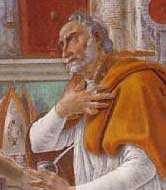| Profile | Major Works | Resources |
Augustine of Hippo, 354-430.

African bishop and Patristic theologian, Aurelius Augustine of Hippo is regarded as one of the four "Great Doctors" of the Church, and arguably the most influential.
Born in Thagaste, the son of a Pagan father and Christian mother, Augustine studied and taught in Carthage during his his youth. It was here that Augustine converted to Manichaeism (a Dualistic Gnostic religion, then making inroads in the Mediterranean). He subsequently moved to Italy, staying first in Rome, and then in the imperial capital of Milan. It was while professor at the imperial academy in Milan that he fell under the influence of St. Ambrose, and converted to Catholic Christianity in 386. He subsequently returned to North Africa, where he established an ascetic community, and went on to be ordained as a priest in 391 and appointed Bishop of Hippo in 395.
Augustine was a prolific writer, fusing Christian theology (which he derived principally from Ambrose) with Neo-Platonist ideas (derived from Plotinus). This is particularly found in his early, more philosophical works of the 380s, like Contra Academicos and Soliloquies. Among his apologetic writings of the 390s, .are several (e.g. such as De Vera Religione, De Utilitate Credendi, and Liber de fide) that attempt to explain the relation between Faith and Reason, most notably embracing the Neo-Platonist idea that because reason, by it method, contains and divides, then God, one and unlimited, is inaccessible to reason, and only accessible to the experience of faith. However, reason and experience of God's works can bear witness. Augustine is perhaps most responsible for the Neo-Platonist medieval Christian view that everything in nature is a symbol of some higher truth, and that therefore each natural object supplies, by analogy and metaphor, knowledge of God.
Augustine's most famous treatise is his apologetic City of God (started 413, but finished only in 426) which defended Christianity against the common accusation that blamed the decline of Rome on the abandonment of Graeco-Roman pagan worship. First half of the book is directly referring to the accusation in the context of Roman history, but the second half is where Augustine launches into speculative philosophy, comparing what he calls the two realms, the kingdom of God and the kingdom of the world, and discussing the relationship between them.
Augustine deployed his pen in polemics against his old comrades, the Manichaeans, but also against other sects and parties, such as the Arians, the Donatists, and, most famously, the Pelagians. A British monk in Rome, Pelagius articulated a doctrine of free will against determinism, and placed man fully in control of his own salvation. St. Augustine in Africa and St. Jerome in Antioch were roused into disputes against the Pelagian doctrine through the 410s. Augustine's solution, a more elaborate Doctrine of Grace and Original Sin, were pronounced in the canons of the Council of Carthage in 1418, which also condemned Pelagianism once and for all. Augustine would be taken up with enthusiasm by Protestants like Martin Luther and John Calvin in the 16th C.
St. Augustine was the primary source for Scholastic philosophy, before the rediscovery of Aristotle in the 13th C. Augustine re-iterated Ambrose's condemnation of usury (e.g De Baptismo contra Donatistas, 400, Lib. 4, ch.9, trans. 1, 2.), without, however, providing new grounds for it.
|
HET
|
|
Resources on St. Augustine
|
All rights reserved, Gonšalo L. Fonseca
